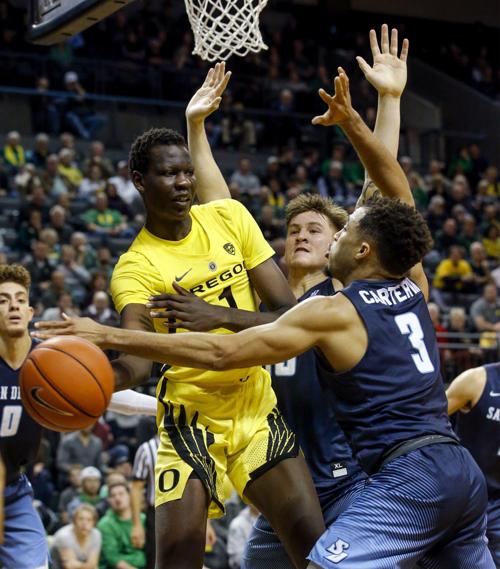Here’s one thing we know with certainty before Thursday’s start of the Pac-12 basketball season: This fragile confederation of men’s basketball teams will not be able to match its dim .514 December winning percentage (38-36).
Between now and early March, the Pac-12 will produce a 108-108 composite record and here’s what it all means:
1. There is truly no lead candidate for player of the year, coach of the year or even freshman of the year. There is no precedent for leaving the annual awards vacant.
The league’s leading scorer is Washington State senior Robert Franks, 22.1, but that’s misleading. The Cougars have played the 344th-ranked nonconference schedule and barely broke .500, at 7-6.
Franks played against just two Top 100 opponents — road and neutral-site games against New Mexico State — and in those games of increased difficulty, Franks averaged just 12 points.
Next.
Oregon 7-foot freshman center Bol Bol, averaging 21 points and 9.6 rebounds, would be the league’s showcase player. Alas, Bol has been sidelined, wearing a protective boot on his foot since Dec. 12. His availability is the league’s most significant development.
Coach of the year? Don’t even ask.
Freshman of the year? Arizona State’s Luguentz Dort was terrific for a few weeks but has since hit the proverbial freshman wall a bit early. Dort shot 20 percent his last five games (9 for 45). I suspect he’ll recover and be a force. If so, he might also be the league’s player of the year.
2. Washington is my choice to win the league championship at 13-5. It would be just the fourth time a Pac-10/12 champion has won as few as 13 games, matching the 1985 Huskies, the 2010 Cal Bears and 2013 UCLA Bruins.
Why Washington, which had an unremarkable 9-4 preconference? The schedule-maker dealt the Huskies the league’s best set of scheduling “misses.” Washington won’t play Arizona or Arizona State at home, and it doesn’t play UCLA or USC in Los Angeles. That’s maybe three potential losses UW is apt to avoid.
Here’s how I have the leader board:
Washington, 13-5. Best defense in a bad league and an inside presence.
Arizona State, 12-6. Possibly the top rotation of seven players.
Oregon, 12-6. If Bol returns, the Ducks could go 14-4 and win it.
UCLA 11-7. Minus underperforming coach Steve Alford, the talent-blessed Bruins might bond and take advantage of a schedule that doesn’t include games in Tucson and Tempe.
Arizona 10-8. The Wildcats will need some McKale magic, because winning more than two road games will be difficult — there will be no freebie at Washington State this winter.
If you can find another team that seems capable of breaking .500, let me know.
3. The programmers at ESPN and Fox Sports bought heavily on Oregon, UCLA and Arizona. Each of those teams have at least 12 games scheduled on those platforms.
If UCLA goes in the tank via its coaching change, the Bruins’ 12 games on ESPN and Fox, plus one on CBS, could be toxic for TV ratings and the league’s already battered image.
The most entertaining team to watch is Arizona State, if only for the sideline dramatics involving Bobby Hurley. Unfortunately, the Sun Devils will play 10 league games on the Pac-12 Networks. Good luck with that.
National programmers avoided Washington State; the Cougars are playing 15 games on the Pac-12 Networks. Here’s hoping TV guys J.B. Long, Roxy Bernstein and Matt Muehlebach survive the foggy midnight drives from Pullman to Spokane,
4. You will probably hear/read that the ’18-19 Pac-12 season is the worst since the 1985 “Wayne Carlander Year.”
Carlander was an above-average forward who was unexpectedly selected the Pac-10 player of the year, which has come to identify the ’84-85 season as the worst of the league’s modern era. How did Carlander get the award? USC was the league co-champion, 13-5, and Carlander averaged a modest 16.5 points.
Even though Carlander didn’t play a minute in the NBA — he was chosen 99th overall in the 1985 draft — he was selected player of the year over some high-profile opponents, such as future NBA first-round picks A.C. Green of Oregon State and Washington’s Christian Welp and Detlef Schrempf.
Green led the Pac-10 in scoring and rebounding. Even Oregon’s 7-foot Blair Rasmussen was a worthy candidate, the No. 15 overall pick in that year’s draft.
A Pac-10 executive once told me that the 10 coaches voting for the 1985 award were split, with Carlander getting four votes, Green three, Schrempf two and Arizona’s Pete Williams one.
Thus the Carlander Year lives in posterity.
5. Plenty of (expensive) tickets are available for the Pac-12 Tournament, March 13-16 at T-Mobile Arena in Las Vegas.
Since the league championships moved from the MGM Grand Arena (capacity 12,916), capacity has increased to 19,000. That’s a lot of tickets to sell in a year that by far the largest source of ticket purchases, Arizona, doesn’t look to be a championship game contender.
Last year, Arizona and USC drew 16,501 in the title game at T-Mobile. A year earlier, Arizona and Oregon drew 18,927 in the final.
Can you imagine how many seats will be unoccupied if, say, Washington and Oregon meet in the championship game this year? It might not hit 7,500. Even a game involving ASU might not reach 10,000.
It’s unfortunate this appears to be a transition year for Arizona. Can you imagine the buzz if ASU and Arizona met for the tournament championship at T-Mobile? Someday soon, please.





